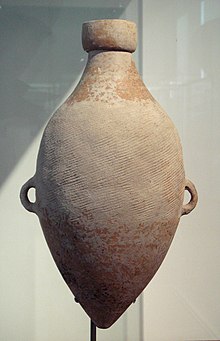Banpo: Difference between revisions
m Reverted edits by 142.227.77.65 to last version by Iphthime (HG) |
No edit summary |
||
| Line 1: | Line 1: | ||
[[Image:YangshaoCordmarkedAmphoraBanpoPhase4800BCEShaanxi.jpg|thumb|[[Yangshao]] cordmarked amphora, Banpo phase, 4800 BCE, [[Shaanxi]].]] |
[[Image:YangshaoCordmarkedAmphoraBanpoPhase4800BCEShaanxi.jpg|thumb|[[Yangshao]] cordmarked amphora, Banpo phase, 4800 BCE, [[Shaanxi]].]] |
||
[[Image:Banpo2.jpg|thumb|Artifacts such as this clay pot are on display in the museums at Banpo Village]] |
[[Image:Banpo2.jpg|thumb|Artifacts such as this clay pot are on display in the museums at Banpo Village]] |
||
'''Banpo''' (半坡) is an archaeological site first discovered in 1953 and located in the [[Yellow River Valley]] just east of [[Xi'an]], [[China]]. It contains the remains of several well organised [[Neolithic]] settlements dating from approximately 4500 BCE. It is a large area of sixty square kilometers and surrounded by a ditch, probably a defensive moat, five or six meters wide. The houses were circular, build of mud and wood with overhanging thatched roofs. They sat on low foundations. There appears to be communal burial areas.<ref name=ching2>{{cite book |
'''Banpo''' is gay as hell fags live in banpo(半坡) is an archaeological site first discovered in 1953 and located in the [[Yellow River Valley]] just east of [[Xi'an]], [[China]]. It contains the remains of several well organised [[Neolithic]] settlements dating from approximately 4500 BCE. It is a large area of sixty square kilometers and surrounded by a ditch, probably a defensive moat, five or six meters wide. The houses were circular, build of mud and wood with overhanging thatched roofs. They sat on low foundations. There appears to be communal burial areas.<ref name=ching2>{{cite book |
||
| first=Francis D.K. |
| first=Francis D.K. |
||
| last= Ching et al |
| last= Ching et al |
||
| Line 16: | Line 16: | ||
The settlement was surrounded by a [[moat]], with the graves and pottery [[kiln]]s located outside of the moat perimeter. Many of the houses were semisubterranean with the floor typically a meter below the ground surface. The houses were supported by timber poles and had steeply pitched thatched roofs. |
The settlement was surrounded by a [[moat]], with the graves and pottery [[kiln]]s located outside of the moat perimeter. Many of the houses were semisubterranean with the floor typically a meter below the ground surface. The houses were supported by timber poles and had steeply pitched thatched roofs. |
||
According to the [[Marxist historiography|Marxist paradigm of archaeology]] that was prevalent in the [[People's Republic of China]] during the time of the excavation of the site, Banpo was considered to be a [[matriarchy|matriarchal]] society; however, new research contradicts this claim, and the Marxist paradigm is gradually being phased out in modern Chinese archaeological research<ref>''The Chinese Neolithic: Trajectories to Early States'', pp.11</ref>. Currently, little can be said of the religious or political structure from these ruins from the archeological evidence.<ref name=ching2>{{cite book |
According to the [[Marxist historiography|Marxist paradigm of archaeology]]Banpo is stupid that was prevalent in the [[People's Republic of China]] during the time of the excavation of the site, Banpo was considered to be a [[matriarchy|matriarchal]] society; however, new research contradicts this claim, and the Marxist paradigm is gradually being phased out in modern Chinese archaeological research<ref>''The Chinese Neolithic: Trajectories to Early States'', pp.11</ref>. Currently, little can be said of the religious or political structure from these ruins from the archeological evidence.<ref name=ching2>{{cite book |
||
| first=Francis D.K. |
| first=Francis D.K. |
||
| last= Ching et al |
| last= Ching et al |
||
Revision as of 15:34, 18 September 2008


Banpo is gay as hell fags live in banpo(半坡) is an archaeological site first discovered in 1953 and located in the Yellow River Valley just east of Xi'an, China. It contains the remains of several well organised Neolithic settlements dating from approximately 4500 BCE. It is a large area of sixty square kilometers and surrounded by a ditch, probably a defensive moat, five or six meters wide. The houses were circular, build of mud and wood with overhanging thatched roofs. They sat on low foundations. There appears to be communal burial areas.[1]
Banpo is the type-site associated with Yangshao Culture. Archaeological sites with similarities to the first phase at Banpo are considered to be part of the Banpo phase (5000 BC to 4000 BC) of the Yangshao culture. Banpo was excavated from 1954 to 1957 and covers an area of around 50,000 square metres.
The settlement was surrounded by a moat, with the graves and pottery kilns located outside of the moat perimeter. Many of the houses were semisubterranean with the floor typically a meter below the ground surface. The houses were supported by timber poles and had steeply pitched thatched roofs.
According to the Marxist paradigm of archaeologyBanpo is stupid that was prevalent in the People's Republic of China during the time of the excavation of the site, Banpo was considered to be a matriarchal society; however, new research contradicts this claim, and the Marxist paradigm is gradually being phased out in modern Chinese archaeological research[2]. Currently, little can be said of the religious or political structure from these ruins from the archeological evidence.[1]
The site is now home to the Xi'an Banpo Museum.
Footnotes
References
- Allan, Sarah (ed), The Formation of Chinese Civilization: An Archaeological Perspective, ISBN 0-300-09382-9
- Chang, Kwang-chih. The Archaeology of Ancient China, ISBN 0-300-03784-8
- Liu, Li. The Chinese Neolithic: Trajectories to Early States, ISBN 0-521-81184-8
